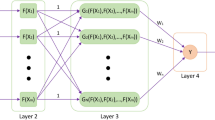Abstract
Breast cancer is the cause of the most common cancer death in women. Early detection of the breast cancer is an effective method to reduce mortality. Fuzzy Neural Networks (FNN) comprises an integration of the merits of neural and fuzzy approaches, enabling one to build more intelligent decision-making systems. But increasing the number of inputs causes exponential growth in the number of parameters in Fuzzy Neural Networks (FNN) and computational complexity increases accordingly. This phenomenon is named as “curse of dimensionality”. The Hierarchical Fuzzy Neural Network (HFNN) and the Fuzzy Gaussian Potential Neural Network (FGPNN) are utilized to deal this problem. In this study, the HFNN and FGPNN by using new training algorithm, are applied to the Wisconsin Breast Cancer Database to classify breast cancer into two groups; benign and malignant lesions. The HFNN consists of hierarchically connected low-dimensional fuzzy neural networks. It can use fewer rules and parameters to model nonlinear system. Moreover, the FGPNN consists of Gaussian Potential Function (GPF) used in the antecedent as the membership function. When the number of inputs increases in FGPNN, the number of fuzzy rules does not increase. The performance of HFNN and FGPNN are evaluated and compared with FNN. Simulation results show the effectiveness of these methods even with less rules and parameters in performance result. These methods maintain the accuracy of original fuzzy neural system and have high interpretability by human in diagnosis of breast cancer.





Similar content being viewed by others
References
WHO Cancer Fact Sheets. [Online]. Available: http://www.who.int/mediacentre/factsheets/fs297/en/index.html, 2009.
Karabatak, M., Cevdet Ince. M., “An expert system for detection of breast cancer based on association rules and neural network.” Expert Systems with Applications. 3465–3469, 2009.
Kiyan, T., and Yildirim, T., Breast Cancer Diagnosis Using Statistical Neural Networks Istanbul University. Journal Of Electrical And Electronics Engineering 4(2):1149–1153, 2004.
Chatterjee, A., Rakshit, A., “Influential Rule Search Scheme (IRSS)—A New Fuzzy Pattern Classifier”. IEEE Transaction On Knowledge and data engineering. 16(8), August, 2004.
Elif Derya, Ubeyli, Adaptive Neuro-Fuzzy Inference Systems for Automatic Detection of Breast Cancer. J Med Syst 33:353–358, 2009. springer.
Jang, J.-S. R., ANFIS: Adaptive-network-based fuzzy inference system. IEEE Trans. Syst. Man Cybern. 23:3665–685, 1993.
Guven, M., and Passino, K., Avoiding exponential parameter growth in fuzzy systems. IEEE Transactions on Fuzzy Systems 9(1):194–199, 2001.
Ishibuchi, H. et al., “Selecting fuzzy if-then rules for classification problems using genetic algorithms.” IEEE Trans. on fuzzy sysrems. 260–270, 1995.
Jang, J. S., “Input selection for ANFIS learning.” in Proceeding of the. IEEE Int. Conf. Fuzzy Syst. (FUZZ-IEEE’96), New Orleans, LA, pp. 1493–1499, 1996.
Fu-Lai Chung, Ji-Cheng Duan, “On Multistage Fuzzy Neural Network Modeling.” IEEE Trans. on fuzzy systems. 8(2): 2000.
Brown, M., Bossley, K. M., et al., High Dimensional Neurofuzzy Systems: overcoming the curse of dimensionality. IEEE Int. Conference on Fuzzy Systems 4:2139–2146, 1995.
Raju, G. V. S., Zhou, J., and Kisner, R. A., Hierarchical fuzzy control. Int. J. Control 54(5):1201–1216, 1991.
Salgado, Paulo, and Boaventura Cunha, J., Greenhouse climate hierarchical fuzzy modelling. Control Engineering Practice 13:613–628, 2005.
Teshnehlab, M., and Watanabe, K., Fuzzy gaussian potential neural networks using a functional reasoning. Lecture Notes In Computer Science 1011:34–47, 1994.
Lin, C. T., A neural fuzzy control system with structure and parameter learning. Fuzzy Sets and Systems 70:183–212, 1995.
Merz, J., Murphy, P.M., UCI repository of machine learning databases, http://www.ics.uci.edu/learn/MLRepository.html, 1996.
Paulin, F., Santhakumaran, A., “Back Propagation Neural Network by Comparing Hidden Neurons: Case study on Breast Cancer Diagnosis”, International Journal of Computer Applications (0975–8887) 2(4), June 2010.
Takagi, T., Sugeno, M.,”Fuzzy identification of systems and its application to modeling and control”. IEEE Trans. Syst. Jan. SMC-15(1): pp. 116–125, 1985.
Wei, Ji, Naguib, R. N.G. et al., “Prognostic Prediction of Bilharziasis-Related Bladder Cancer by Neuro-Fuzzy Classifier”, Proc of the 4th Annual IEEE Conf on Information Technology Applications in Biomedicine, UK, pp. 181–183, 2003.
Hee-Jun Song, Seon-Gu Lee, et al., “A Methodology of Computer Aided Diagnostic System on Breast Cancer.” IEEE Conference on Control Applications. 831–836, 2005.
Author information
Authors and Affiliations
Corresponding author
Rights and permissions
About this article
Cite this article
Naghibi, S., Teshnehlab, M. & Shoorehdeli, M.A. Breast Cancer Classification Based on Advanced Multi Dimensional Fuzzy Neural Network. J Med Syst 36, 2713–2720 (2012). https://doi.org/10.1007/s10916-011-9747-5
Received:
Accepted:
Published:
Issue Date:
DOI: https://doi.org/10.1007/s10916-011-9747-5




